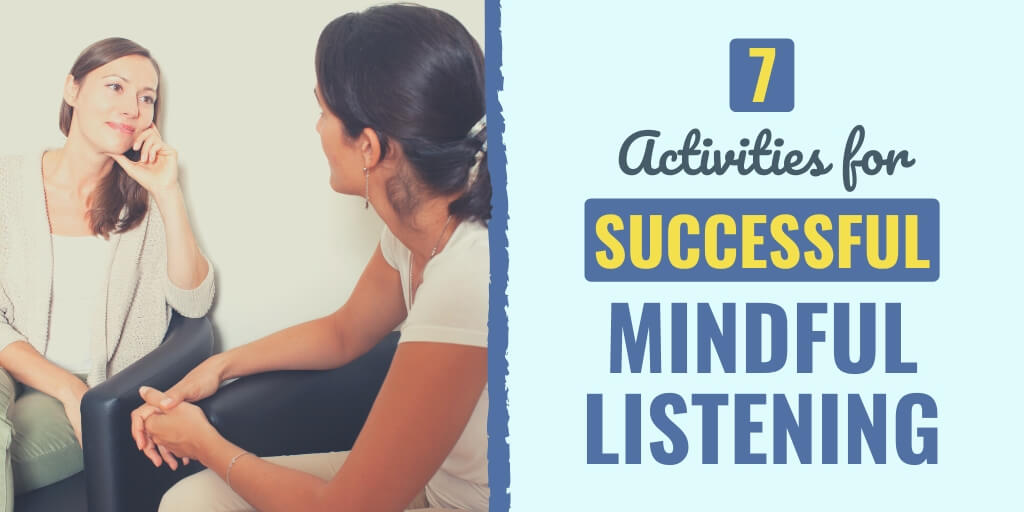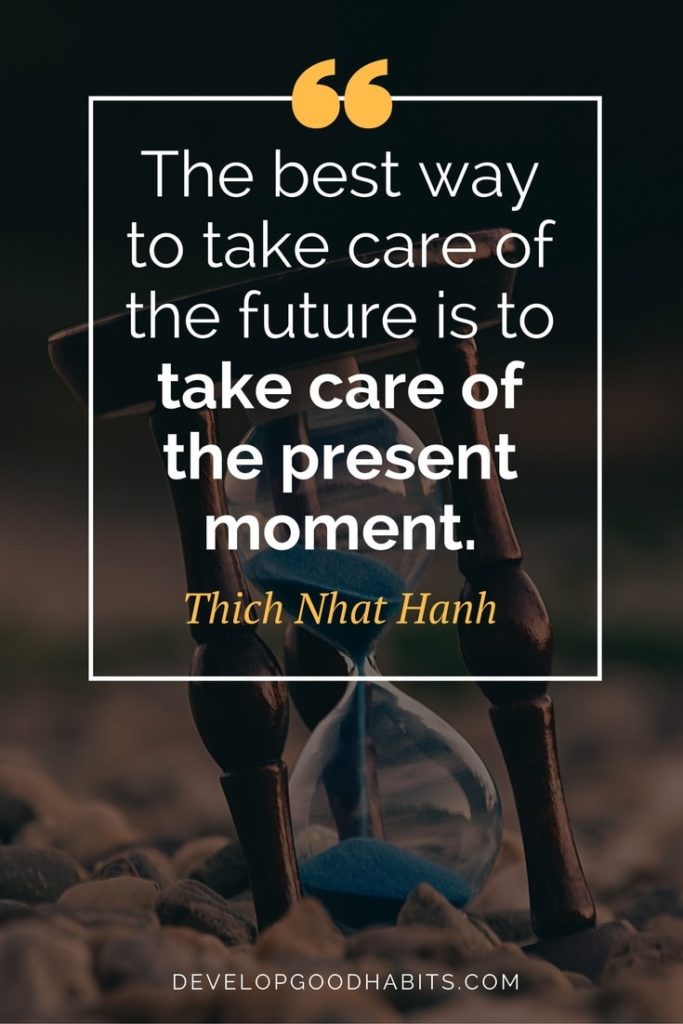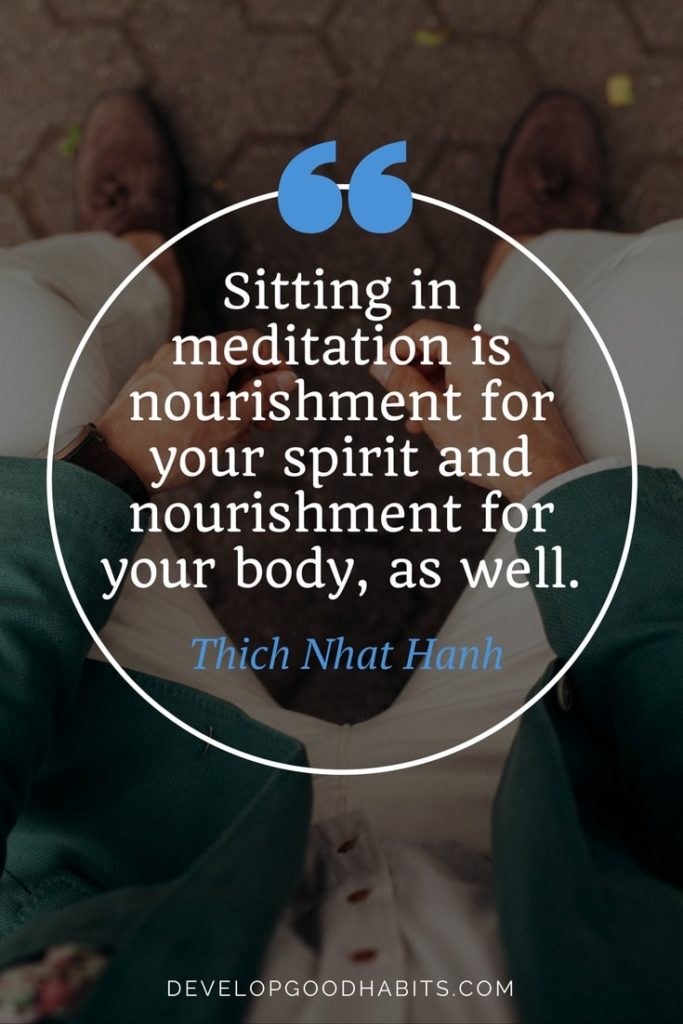There might be affiliate links on this page, which means we get a small commission of anything you buy. As an Amazon Associate we earn from qualifying purchases. Please do your own research before making any online purchase.
What is mindful listening? How is it different from normal listening?
Have you ever stopped and realized in a group conversation, meeting, or even just a talk with a friend that you really don't even know what you're talking about?
If you're like most people, this happens quite frequently. While you may be interested in the topic at hand, your mind will still drift off to thinking about something else that is going on in your life.
Our brains are scattered and our minds are unruly, which is why practicing mindful listening can be a crucial part of a meaningful and attentive conversation.
You have to be in the present moment to absorb what is being said. You also have to listen without judgment, and without trying to formulate what you are going to say in response.
What Is Mindful Listening?
Mindfulness is the practice of paying purposeful attention to the present moment, without making any judgments.
It encourages one to be aware of the present and let go of worries or anxieties, along with any physical or emotional reactions you may have to outside influences.
Listening in this way requires you to give your full focus to the person who is talking, and to use your senses to understand their words and emotions.
You must do this while being open-minded, and show that you are taking interest in what the other person is saying. Without being mindful, you may become distracted and fail to hear what someone else is doing or saying.
Studies have suggested that the average person only remembers 25% of what someone has told them only a few minutes prior to being asked.
The goal of mindful listening is to stop your running thoughts so you can hear the message that is being shared with you, and so the speaker can feel understood. It is important to allow yourself to have the time to absorb everything the other person is saying.
According to American author David Augsburger, “Being heard is so close to being loved that for the average person, they are almost indistinguishable.”
Personal Benefits of Mindful Listening
1. Mindful listening helps increase your empathy.
Empathy refers to the ability to understand another person and share what they are feeling.
When you are practicing mindful listening, you will increase your empathy because you will be taking the time and energy to put yourself in someone else's position, and really listen to what they are saying and their motivations behind engaging in the conversation with you.
2. Mindful listening further develops self-awareness.
Mindful listening will allow you to be conscious of your physical and mental presence throughout the conversation.
It may also help you uncover some unknown biases that you have when listening to someone else's perspective or point of view. Self-awareness is a critical part of being mindful because it allows you to always be in the present moment.
3. Mindful listening helps deepen relationships.
Part of being mindful is being able to know yourself well enough to be able to create deep relationships with other people.
If you are able to give someone your full attention by listening in a mindful way, you will be able to get to know them on a level that you otherwise would miss. The more you are able to understand someone, and vice versa, the deeper your relationship will be.
4. Mindful listening improves your focus and attention.
Practicing your focus while you are in a conversation will spill over to other aspects of your life. You will be able to gradually learn how to quiet your busy mind and pay attention only to what is being said to you.
Professional Rewards of Mindful Listening
1. Mindful listening improves your communication with colleagues, encouraging collaboration and initiative.
As a mindful listener, you will be able to improve your work with your colleagues.
With proper communication, you and your colleagues will be able to listen to each other to learn about each other's ideas and thoughts about possible projects. Working together as a conducive team will allow you to better your work.
2. Mindful listening helps you make stronger connections.
With mindful listening, you are able to connect to the person to whom you are talking by taking the time to fully understand what they are saying and why they are sharing it with you.
This will help to build a stronger connection because you can relate to what they are saying.
3. Mindful listening increases productivity because people are actually listening.
When people take the time to listen, they will also be able to engage in the conversation and add in their own thoughts to build off what the other person is saying.
This can help people stay productive because it leaves little time to get off track or to put off short-term goals.
4. Mindful listening boosts workplace morale because employees feel they are appreciated and listened to.
When people feel like they are being listened to, they feel as if they are a part of the group.
This is important in feeling valued as an employee. Also, employees who feel heard in their company are more likely to remain loyal employees than those who feel as if their opinions do not matter.
5. Mindful listening improves observational skills, allowing leaders to choose the best persons for projects or to delegate tasks to.
When you are listening closely to someone, you may pick up on some subtle things that you would not otherwise notice.
For example, you might notice that one employee has a great attention to detail when it comes to numbers or some aspect of a project that will be really important. If you are trying to get to know someone, it is vital to practice mindful listening.
Examples of Mindful Listening
Repeat back what someone else has said, but put it into your own words. This will allow your speaking partner to know that you have been listening and comprehending what they have been talking about.
Use your own words to tell the person what they just told you. Tell them that this is what you heard them say, and ask if that was the intended meaning. This will allow both of you to be clear on the message that was portrayed.
Encourage your speaking partner to tell you more by nodding and smiling, and even asking them to tell you more. This will let them know that you are interested in what they have to say, and that you believe what they are saying has value.
Make sure that you are on the same level physically. Don't talk down to someone or have someone talk down to you. You want your eyes to be on an equal plane so that, both physically and metaphorically, you are on the same level.
If you find yourself cutting the other person off to interject your own opinion, apologize and allow them to return to what they were saying. Be conscious to try to not interrupt people in the first place.
It is not uncommon to be in a conversation and think about what you are going to say next while the other person is talking. Instead, allow the other person to finish what they are saying, and have an open mind. Once they are finished, you can take some time to process what they said and formulate a response.
Take a quick pause before responding to what the other person has been saying. Use this time to absorb what they said without any judgment, and then translate back to them what you heard them say in your own words.
In order to respond without judgment, it is sometimes important to take a breath and gather your thoughts. Formulate a proper response to the person to whom you are speaking that will show that you are interested in what they said, and that you understand it as well.
Before a conversation even starts, you should set the intention to listen mindfully. Remind yourself that this is your time to give someone else your full attention and respect their willingness to take the time to talk to you. Get the most you can out of the conversation by listening in a mindful way on purpose.
If you are not able to give the other person your full attention at the moment, choose another time to have the conversation.
It is ok to ask someone to reschedule a conversation, especially if you tell them that you will be able to give them your full attention at a later time. This will help them realize that you value what they are going to say.
Put aside any distractions like your phone or any other gadget. There is nothing worse than trying to be heard while the people to whom you are speaking are busy looking at their phones.
It makes it seem like what the speaker is saying is not very important. Have the courtesy to put away anything that could be distracting while you are giving your full attention to another person.
Encourage dialogue by asking open-ended questions. Saying things such as “Tell me more” or “Tell me about a time when…” encourages people to speak more than giving a one-word answer. This also opens up the floor to additional conversations and may lead to talking about something else as well.
Let the speaker share their thoughts; avoid finishing their sentences. You want to hear what the other person has to say, which may be quite opposite from what you assume it will be.
Allow the person to whom you are speaking to take pauses to think about what they are going to say next, and really value every idea that they choose to share with you.
Notice your thoughts, feelings, and body sensations as they arise. Be mindful of yourself in the present moment, and monitor how the conversation is making you feel.
Do you agree with everything, and are you, therefore, relaxed and happy? Or are there some things you might not agree with, and maybe you get tense throughout the conversation?
Pay attention to the other person’s tone and body language. Mimic their affect so they feel comfortable in the conversation with you. If their tone of voice is happy and active, then respond in a similar manner. If they are down and solemn, don't respond by giggling or showing excitement.
Mindful Listening Exercises
1. The mindful listening practice
To do this, find someone who is willing to work with you, such as a friend or someone who is in your family. Each person will take turns speaking for three uninterrupted minutes.
When it is your turn to speak, don't worry about the topic. Just speak about whatever you want for three minutes straight. It is ok if you run out of things to say before the three minutes is up. You can also take a few breaks while you are speaking to gather your thoughts.
Once your time is up, allow your partner to speak for three minutes without interrupting him or her. Do this back and forth at least twice so you both get an ample amount of time to talk.
2. Stop whatever you are doing and just listen.
This sounds easy! It is quite simple, but you do have to remember to concentrate while you are listening so your mind does not wander off to other topics or subjects.
Set aside the amount of time that you want to spend practicing mindful listening, and stick to it. If it is just five minutes, that is fine, but make sure that your mind does not wander during those five minutes.
Allow any sounds that you hear to anchor you in the present moment. Remember to not pass any judgment during this time, or to try to analyze the things that are going on around you.
Simply accept what you hear and allow yourself to experience it. If you become impatient, notice what is happening, and slowly redirect your attention to the sounds around you. Do not react to your feelings of restlessness.
3. Mindfulness-awareness meditation
If you are able to take a moment to do some seated meditation, keep this exercise in mind. When you are practicing peaceful abiding, you will learn to settle and continue to return to the present by letting your thoughts pass by without acting on them.
During this process, you can see how your own self-absorption prevents you from experiencing so much of the world. Being able to let go of yourself is an important first step in allowing you to hear and see other people completely.
Doing this type of practice is an important way to get to know yourself in a whole new way, and is based on the idea of being gentle and accepting oneself.
4. The Alexander technique
Meditation helps us gain control over our life circumstances. The Alexander technique teaches us to notice how we tend to interfere with our own lives. Instead of doing more, we are able to learn to let go of the things we are doing that are standing in our way.
It may be difficult to pinpoint your everyday habits that might be keeping you from reaching a final goal because you are so used to doing them. In fact, your routine likely feels like it is just right for you.
For example, someone whose legs continuously hurt during their daily run may not think that it is because of the shoes they have been wearing for months.
The shoes may feel perfect to them, and could even be the same brand they have used the entire life. However, in an Alexander lesson, this person is guided to a more appropriate shoe for their running style, which may even feel wrong at first.
Sometimes it is important to notice your daily habits and realize that, while they are comfortable, they may be causing you trouble somewhere else in your life.
Be comfortable with being uncomfortable for a while during the time that you are trying out something new, and it may leave you with long-lasting benefits.
5. Focusing
Being able to fully focus requires you to have three skills: intuition, self-awareness, and a caring presence. This is a contemplative practice that became popular in Western philosophy and psychology.
Being able to cultivate these inner skills will allow you to understand your life experience, make decisions, and solve problems.
This type of focusing requires you to notice how you feel, and welcome those feelings without judgment. These feelings and senses typically go unnoticed or fall below your radar of attention, but they can be recognized if you allow yourself to be receptive to them.
Felt senses are not only physical. They may be vague at first, or even non-conceptual, but they relate to parts of your life like your work or relationships, and they tell more about the person you are.
6. Mindfulness bells
Mindfulness bells are used as a focal point for mindfulness meditation. They have been successfully used for centuries. These specially prepared mindfulness recordings allow you to listen in a mindful way to a deeper and powerful form of meditation.
Concentrating on this kind of focused listening is a great way to learn how to meditate, especially if you are new to the practice. This is also a great way to develop an effective mindfulness technique to help you clear your mind when you are feeling stressed or overwhelmed.
7. Mindfully listen to music.
Find some music that you have never listened to before. It does not have to be something that you are even very interested in—just find something that you are unfamiliar with.
The idea here is to learn to listen intently to the sounds and to become fully entwined with the creation of the music, without having a judgment about the genre or lyrics of the song.
Don't think about what you are listening to—just hear it.
For other mindfulness habits that you can develop, take a few minutes to watch the video below to learn about morning routine ideas that can help you become more mindful on a daily basis.
Final Thoughts on Mindful Listening
In conclusion, now that you know what mindful listening is, practice it a little bit every day until it becomes natural to you.
Whenever you are listening to someone talk, listen mindfully and intently, and give them the respect they deserve. Doing these things will get you on the right track to learning how to do mindful listening, and with enough practice, it will become second nature.
One thing that can help is to create and follow through SMART goals to improve your listening skills. If you want to practice other mindfulness exercises every day, check out our roundup of the best mindfulness worksheets that can help you stay on track.
See some more posts on being present in the moment and learning to listen:
- 8 Simple Ways to Be a Good Listener in Conversations
- 67 Mindfulness Quotes to Live in the Present Moment
- 11 Active Listening Exercises to Become A Better Listener
Finally, if you need help with building habits, then check out this nine-step blueprint that walks you through the entire process of creating lifelong habits.)





